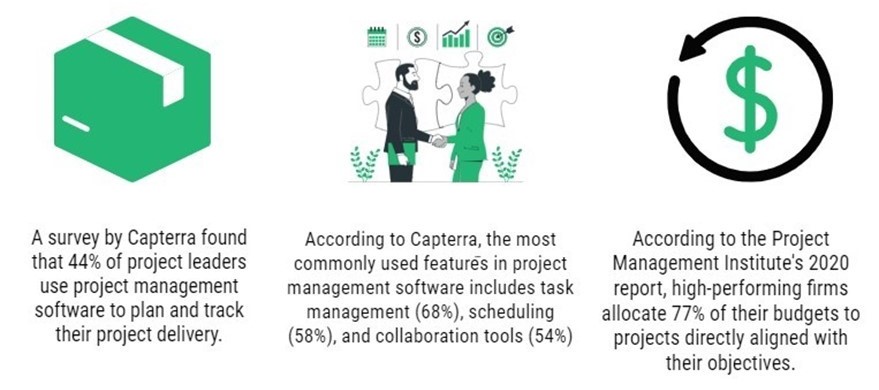
Predictive analytics has emerged as a powerful tool in the realm of data-driven decision-making, offering businesses the ability to forecast future trends and outcomes based on historical data patterns. This sophisticated approach to predictive data analytics has revolutionized the way organizations operate, enabling them to make proactive and strategic choices that drive success in today's competitive landscape. By harnessing the potential of predictive statistics, businesses can unlock valuable insights, optimize processes, and enhance project delivery.
Understanding Predictive Analytics
Predictive analytics is an advanced data analytics technique that uses historical data, statistical algorithms, and machine learning to predict future outcomes and trends. It goes beyond mere descriptive and diagnostic analysis, empowering organizations to make proactive and data-driven decisions. It enables businesses to optimize operations, improve customer experiences, increase profitability, and enhance project delivery efficiency. By leveraging predictive analytics, project leaders and teams can identify potential roadblocks, allocate resources effectively, and proactively address project risks, ultimately leading to successful project outcomes.

Why Predictive Data Analytics Matters
- Proactive Decision-making: By predicting potential risks and challenges, you can make proactive decisions to mitigate adverse impacts.
- Optimized Resource Allocation: Predictive analytics enables efficient allocation of resources, ensuring they are utilized optimally throughout the project lifecycle.
- Accurate Project Timeline Forecasts: Organizations can rely on predictive analytics to forecast project timelines more accurately, leading to better planning and resource management.
- Improved Project Planning and Execution: Predictive analytics provides valuable insights to optimize project planning and execution, resulting in smoother operations and timely delivery.
- Enhanced Risk Management: Predictive analytics helps you identify potential risks and vulnerabilities, allowing for the implementation of robust risk management strategies.
- Real-time Performance Monitoring: Through predictive analytics, you can monitor project performance in real-time and take corrective actions promptly.
- Data-Driven Decision-making: Predictive analytics empowers project teams to make data-driven decisions, reducing reliance on intuition and subjective judgment.
Key Benefits of Predictive Analytics
Predictive analytics offers a wide range of benefits that extend to various aspects of business operations, including project management. By leveraging predictive analytics, organizations can gain valuable insights and make informed decisions to optimize project planning, execution, and delivery.
- By leveraging this approach, organizations can optimize their project planning processes and ensure efficient resource allocation. Here are some key benefits of predictive planning in project management:
- Enhanced Resource Allocation: Predictive analytics helps you identify resource requirements and allocate them optimally. By analyzing historical data and project performance, organizations can better understand resource utilization patterns, leading to improved allocation and reduced resource bottlenecks.
- Accurate Project Timelines: Predictive analytics enables project leaders to estimate project timelines more accurately. By analyzing past project data and identifying bottlenecks, organizations can set realistic deadlines and create achievable project schedules.
- Risk Mitigation: Predictive analytics can identify potential risks and uncertainties in a project. By anticipating risks early on, project leaders can develop contingency plans and proactive risk mitigation strategies, reducing the impact of unforeseen challenges.
- Budget Optimization: By analyzing historical project data, organizations can optimize budget allocation and ensure that projects are delivered within budget constraints. Predictive analytics helps identify cost overruns and enables better financial planning.
- Predictive DevOps can significantly streamline the software development lifecycle and improve collaboration between development and operations teams. The benefits of predictive DevOps are as follows:
- Continuous Integration and Deployment: Predictive analytics enables continuous integration and deployment by identifying potential bottlenecks and issues in the development process. This allows for faster and more reliable software releases.
- Proactive Issue Detection: Predictive analytics can detect potential issues and defects in the software early on. This helps you in addressing problems before they become critical, reducing the chances of post-release defects, and enhancing software quality.
- Automation and Efficiency: By leveraging predictive analytics, organizations can automate repetitive tasks in the software development process. This leads to improved efficiency, shorter development cycles, and a faster time-to-market.
- Improved Customer Experience: Predictive analytics can analyze customer feedback and usage data to identify areas of improvement in the software. By making data-driven changes, organizations can enhance the overall customer experience.
- Predictive analytics can revolutionize the software testing process by enabling organizations to prioritize testing efforts, detect defects early, and improve overall software quality. The benefits of predictive quality and testing are as follows:
- Test Coverage Optimization: Predictive analytics ensures that testing efforts are focused on high-risk areas, leading to improved test coverage.
- Early Defect Detection: By using predictive analytics, organizations can detect defects early in the development process. This allows for quicker resolution of issues, reducing the cost and effort required for defect fixing.
- Test Automation: Predictive analytics can help identify suitable test cases for automation. Automated testing improves testing efficiency, reduces manual effort, and enhances test accuracy.
- Performance Optimization: Predictive analytics can analyze performance testing data to identify bottlenecks and areas for improvement. This leads to better-performing software and improved user experiences.
Predictive Analytics Models
Predictive analytics models are sophisticated statistical algorithms and machine learning techniques used to predict future outcomes based on historical data patterns and trends. These models play a crucial role in leveraging the power of predictive analytics to make proactive and data-driven decisions.
- Customer Lifetime Value Model: Predict the future value of customers to optimize marketing and retention strategies.
- Customer Segmentation Model: Segment customers based on behavior and preferences to target specific demographics.
- Predictive Maintenance Model: Anticipate equipment failures to implement preventive maintenance and reduce downtime.
- Quality Assurance Model: Predict software defects and issues to ensure a high-quality product release.
Using Predictive Analytics to Boost Project Delivery
Predictive analytics techniques play a significant role in boosting project delivery by providing valuable insights and facilitating data-driven decision-making throughout the project lifecycle. Here are some ways in which predictive analytics can be used to enhance project delivery:
- Resource Management: Predictive analytics enables project leaders to allocate resources efficiently, ensuring that the right skills and expertise are available at the right time. By optimizing resource allocation, project teams can avoid bottlenecks, reduce idle time, and enhance productivity, ultimately leading to faster project delivery.
- Risk Identification and Mitigation: Predictive analytics can identify potential risks and challenges early in the project, allowing project leaders to proactively develop risk mitigation strategies. This proactive risk management approach minimizes the impact of unforeseen challenges and reduces project delays, ensuring smoother project delivery.
- Project Timeline Estimation: By considering past project performance, resource allocation, and delivery patterns, you can set realistic deadlines and avoid overcommitting to unrealistic timeframes. Accurate timeline estimation enhances project planning and execution, leading to on-time project delivery.
- Quality Assurance and Testing: Predictive analytics can identify potential defects and quality issues during the development process. By analyzing past testing data and identifying patterns, predictive models can help prioritize critical test cases and focus testing efforts on high-risk areas. Early detection of defects allows project teams to address issues promptly, reducing the need for rework and ensuring a higher quality of deliverables.
- Project Performance Tracking: Predictive methods enable real-time monitoring and tracking of project performance. By analyzing key performance indicators (KPIs) and comparing them with historical data, project leaders can identify deviations and take corrective actions promptly.
- Budget Optimization: Predictive analytics can assist in optimizing project budgets by analyzing historical cost data and identifying cost-saving opportunities.
- Stakeholder Management: Predictive analytics can analyze stakeholder data and feedback to predict stakeholder expectations and preferences. This information helps you tailor communication strategies, manage stakeholder engagement effectively, and ensure alignment with stakeholder needs. Satisfied stakeholders are more likely to support the project and contribute positively to its success.
By leveraging the power of predictive analytics tools, you can optimize project planning, enhance risk management, and ensure timely and high-quality project delivery. Stay ahead of the competition and make data-driven decisions that drive project success and business growth. TrueProject can significantly improve project delivery operations by streamlining processes, enhancing collaboration, and providing real-time visibility into project progress. TrueProject provides a centralized repository for all project-related information, including tasks, timelines, resources, and documentation. This centralized approach ensures that all team members have access to the most up-to-date information, reducing the risk of miscommunication and ensuring everyone is on the same page.
More information on TrueProject can be found at: TrueProjectInsight.com
 About the Author
About the Author
Brian Eckert is the Director of Engineering for TrueProject. Brian has 30+ years of experience in software development and process. He specializes in Requirements Analysis, Software Project Management, and SDLC.
Endnotes
- BigTime Marketing. “Predictive Analytics for Services Organizations to Forecast Project Management.” March 29, 2022. https://blog.bigtime.net/predictive-analytics-to-forecast-project-management
- Farmer, Donald. “Benefits of predictive analytics for businesses.” TechTarget, December 17, 2021. https://www.techtarget.com/searchbusinessanalytics/tip/Benefits-of-predictive-analytics-for-businesses
- Janardhanan, Raghavan, Johnston, Shannon, Balaji, Arjun, and Kaka, Noshir. “How predictive analytics can boost product development.” McKinsey, August 16, 2018. https://www.mckinsey.com/industries/technology-media-and-telecommunications/our-insights/how-predictive-analytics-can-boost-product-development
- Olavsrud, Thor and Edwards, John. “What is predictive analytics? Transforming data into future insights.” CIO, February 10, 2023. https://www.cio.com/article/228901/what-is-predictive-analytics-transforming-data-into-future-insights.html
- Scheier, Robert L. “How predictive software delivery can cut costs, improve quality.” TechBeacon. https://techbeacon.com/enterprise-it/how-predictive-software-delivery-can-cut-costs-improve-quality





